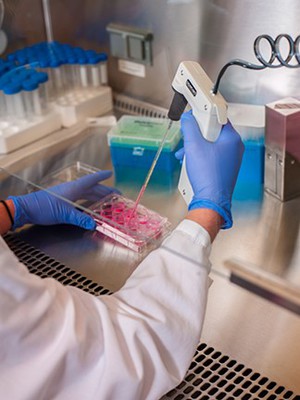Platelet-Rich Plasma: SPRI Leads Research into Promising Method of Treatment

Unfortunately, most musculoskeletal tissues (ligaments, tendons, muscles, bones, and cartilage) that are diseased, injured, or genetically flawed are not capable of fully restoring themselves to normal form or function.
With the increasing prevalence of musculoskeletal disorders, the use of biologics has become an appealing treatment in sports medicine and orthopaedic surgery.
Platelet-rich plasma (PRP) is one of the most promising sources of natural biologic factors. It has the potential to treat non-surgical conditions in a conservative manner, enhance surgical procedures when they are called for, and help with the healing processes.
PRP has been used in several areas in addition to sports medicine and orthopaedic surgery. Among them are wound healing, cosmetics, dentistry, neurologic diseases, cardiothoracic (chest/heart/lung) procedures, and ear/nose/throat disorders. PRP application in sports medicine and arthroscopy ranges from repair of bone, cartilage, tendons, and ligaments to tissue regeneration and biologic augmentation (making a biological system work more efficiently).
HOW PRP IS OBTAINED
PRP is obtained by drawing blood from a patient and concentrating it into a smaller volume that yields a higher platelet concentration. The process takes less than 15 minutes and produces three to four times the amount of platelets and growth factors that are contained in the original blood. This component of the blood rich in platelets is extracted and delivered to the patient. The remainder is discarded.
Patient PRP composition depends on the blood analyzer device, rate of spin, amount of blood extracted, and the number of centrifugations (the use of centrifugal force). These variations directly influence platelet, growth factor, and white blood cell (WBC) concentrations. Even the time of day that the blood is extracted can affect the level of platelet concentration.
WBC concentration, in turn, can affect the effectiveness of PRP. Recent studies suggest that PRP with low WBC concentration is more beneficial for acute injuries and joint conditions, while PRP with high WBC concentration should be used for chronic or extra-articular (outside a joint) abnormalities. WBCs are advantageous in chronic conditions because they produce an inflammatory response that induces natural healing responders.
WHAT PLATELETS DO
Platelets play an important role in clotting blood and regulating proteins in plasma. The benefit of concentrating and increasing the number of platelets is to release important proteins that are capable of activating healing and regeneration mechanisms, while reducing inflammation.
For instance, platelets release a protein that is key in regenerating blood vessels in muscles, ligaments, and tendons. The protein is referred to as vascular endothelial growth factor (VEGF). VEGF induces the formation and growth of new blood vessels that deliver essential nutrients needed to aid in the reconstruction and regeneration of injured or degenerating tissue.
Newly formed vessels contain and produce stem cells that are capable of differentiating into various types of tissue cells that replace old or injured tissue cells.
NOT A SINGLE THERAPY FOR ALL CONDITIONS
The scientific community is beginning to understand that platelet-based compounds have many roles, and are not characterized as a single therapeutic approach for all musculoskeletal tissues.
Although VEGF is a preventative factor in progressive cartilage degeneration, it also inhibits the formation of new cartilage. Therefore, VEGF is not a beneficial factor in cartilage regeneration.
Conversely, transforming growth factor-B1 (TGF-B1) is a protein released from platelets that has the ability to repair cartilage and transform stem cells into cartilage cells. But TGF-B1 creates harmful, scar-like tissues that impede skeletal muscle healing.
A delivery method that eliminates detrimental factors and amplifies factors that promote healing to the targeted tissue will maximize the potential of PRP therapy. More research is needed to identify composition characteristics and synergistic effects between the platelets and growth factors present in PRP.
Additionally, the potential application of a slow-release delivery method that provides platelet- and growth factor-sustainability is crucial. Future research should focus on maintaining and prolonging the effect of this compound.
PRACTICAL APPLICATIONS
PRP has been used in reconstructing and regenerating bone, ligament, tendon, muscle, and cartilage tissue. It has been applied to cartilage defects in a defined area and to arthritic joints such as the knee, shoulder, and hip.
PRP has been extensively observed in acute and chronic conditions of the knee. It has been effective in lessening pain, while improving range of motion and quality of life. However, these improvements are short lived—sometimes lasting only a few months.
A recent review assessed improvements after PRP treatment in cartilage defects and found that intra-articular PRP injection is a viable treatment method up to 12 months in early-stage osteoarthritis. Adverse skin reactions were the most reported complication.
Thus, PRP is a potential therapeutic tool for reducing pain and improving quality of life, but well-conducted clinical studies with a longer follow-up are needed to assess the real efficacy and safety.
FUTURE STUDIES
PRP processing (extracting PRP from a patient’s blood) has been inconsistent. As a first step, a standardized method to produce consistent platelet count and growth factor concentrations should be developed. Establishing a standardized methodology of PRP (extraction volume, time, rate, hematology analyzer, and dosage) will minimize variations.
In addition, donor demographics may be a pertinent component to the puzzle. Observing statistical data may clarify the peak time for drawing blood and determine the influence of gender on platelet and growth factor concentrations.
Finally, tailoring PRP by amplifying healing factors—while inhibiting detrimental factors—would maximize both tissue healing and regeneration.

